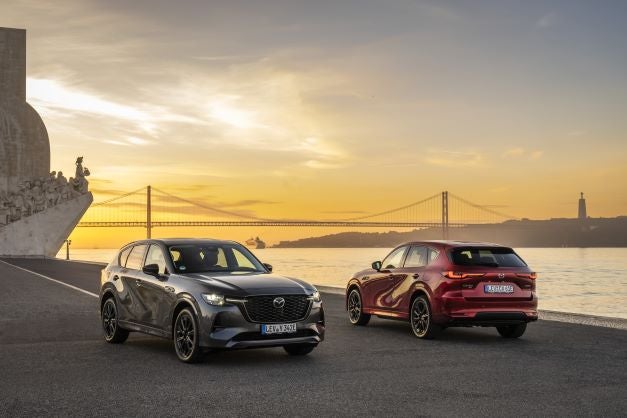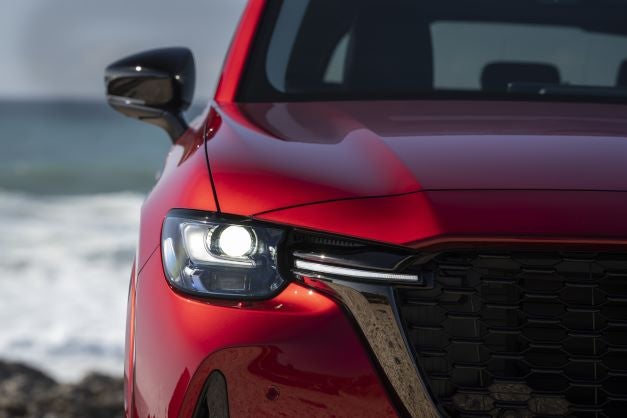
Those familiar with Mazda’s older (though regularly updated) CX-5 SUV, which accounts for about 25% of the brand’s UK sales, will get a few surprises when examining the new CX-60 which reached showrooms this autumn. One is that the heavy bonnet (hood) now raises with hydraulic strut help – a huge improvement – the second is the engine faces the wrong way and about a third of said engine appears to be missing.
This reminds me of the 1980s Holden Commodore which could be had with I4, I6 and V8 engines, the I4 cowering back at the firewall with a giant fan shroud filling the two cylinder gap. This new Mazda comes initially with a PHEV powertrain – the brand’s first – combining an I4, 2.5-litre ICE engine and an electric motor while two I6s follow later in diesel and petrol forms. J’approve. The rest of the car will appear familiar, if updated, to owners of older Mazda SUVs.
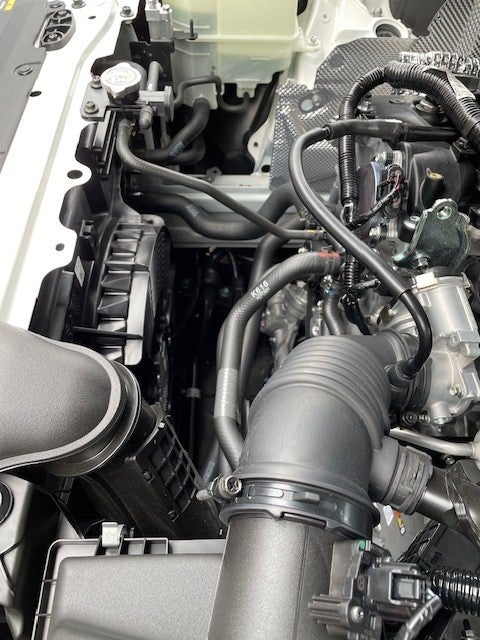
The combination of a Skyactiv-G 2.5-litre four-cylinder petrol engine with a 129kW electric motor and a 355V, 17.8 kWh high-capacity lithium ion battery, delivers a total system output of 327ps and torque of 500Nm making it the most powerful road car Mazda has ever produced. WLTP combined fuel consumption is 188mpg and WLTP combined CO2 emissions are 33g/km.
Mazda claims 39.15 miles of combined electric motor powered driving with the vehicle running at 62mph or less and 0-62mph in just 5.8 seconds. Both claims proved justified with the biggish SUV a fast sprinter off the mark yet 40 miles of electric running was easily achieved. ‘Refuelling’ via a domestic 3-pin plug cost around GBP5 according to my smart meter and took around six hours. The petrol filler is on the left and the electric plug on the right – a light in the opening advises charge state and more info can be obtained by switching on the instrument cluster.
The coming I6 three-litre e-Skyactiv X petrol and 3.3-litre e-Skyactiv D diesel engines have M Hybrid Boost – Mazda’s 48V mild hybrid system – and are said to combine high output with excellent fuel economy and emissions performance. Both powerplants are mated to the same eight speed automatic transmission and i-Activ all wheel drive system as the PHEV, but the e-Skyactiv D diesel unit and the e-Skyactiv X petrol engine have also been developed to be equipped with rear wheel drive only.
The PHEV’s e-Skyactiv powertrain is mated to a new eight-speed automatic transmission (CX-5 has six speeds) and i-Activ all wheel drive and Intelligent Drive Select (Mi-Drive) offers Normal, Sport, Off-Road, Towing and EV drive modes with the all digital instrument cluster changing colour and info to reflect the changing mode. This model switches from primary front wheel drive to primary rear, with AWD kicking in as necessary.
The new eight-speed automatic transmission shifts gears in the same manner as a torque converter transmission – via planetary gears and multi-plate clutches – but it does not have an hydraulic converter as an input clutch, instead it has a multi-plate clutch as well as an integrated electric motor/generator. By replacing the torque converter with a clutch, the torque of the engine and motor is transmitted directly, with fast and rhythmic shifting much like a manual transmission. In addition, the clutch’s friction transmission and cooling functions have been evolved to achieve smooth starting and high efficiency.
The PHEV hybrid powertrain allows for the independent power mixing of the petrol engine and electric motor, and the new transmission helps to implement this smoothly at all speeds. The compact design of the eight speed transmission and the optimal layout of the entire powertrain effects a smaller transmission tunnel space, minimising the impact on the pedal box space and cabin space.
The CX-60’s i-Activ all wheel drive system makes use of the rear wheel drive-based AWD platform to maintain the balanced cornering characteristics of rear wheel drive with the added stability of all wheel drive. The hybrid system and AWD system work with the regenerative braking to optimise front and rear wheel regenerative distribution so more energy can be recovered from all four tyres during deceleration.
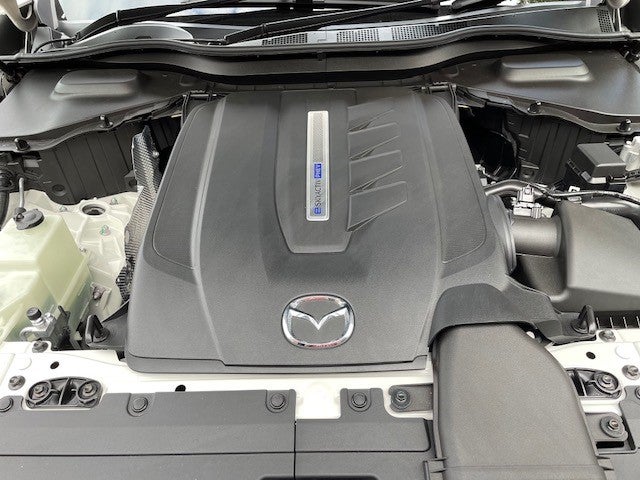
The UK gets three trim grades: Exclusive-Line, Homura and Takumi and there are two option packs across all grades: Convenience Pack and Driver Assistance Pack, with a Comfort Pack available on Exclusive-Line. An additional option to specify a panoramic roof on Homura and Takumi models is also a Mazda first.
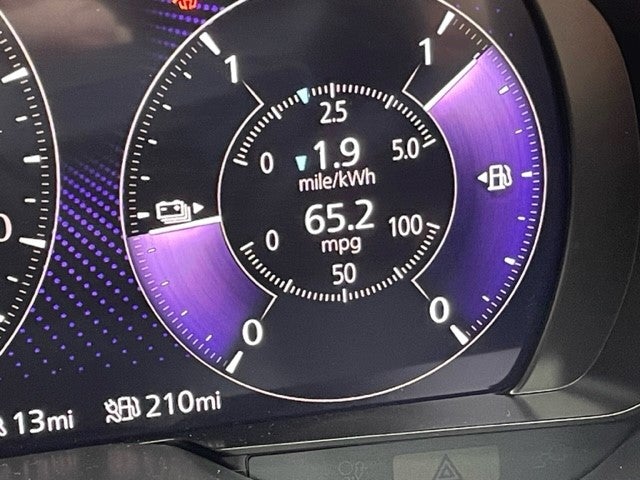
There’s the rub, though. Prices range from GBP43,950 thru GBP46,700 to GBP48,050 with option packs costing GBP1,000 or GBP1,100 and the panoramic roof is another GBP1,000. Although it’s not quite a direct comparison, the top CX-5 essentially chucks everything in that’s optional for the CX-60 and the top trim price is a not insubstantial GBP20,000 more for the newer model – electrification is expensive.
Base trim is still pretty well equipped, however, with mid level Homura adding body coloured wheel arch mouldings and a dark plated signature wing grille surround, plus gloss black mirrors and honeycomb grille treatment, and 20-inch black alloy wheels. Inside, there’s seat heating for the outer rear seats and ambient lighting, plus a new driver personalisation system which will recognise the occupant of the driver’s seat via facial recognition and automatically adjust the surroundings – seat position, steering wheel, mirrors, head-up display, sound and climate control settings. A head-up display is standard across the board and electric steering column adjustment is a first for a UK market Mazda.
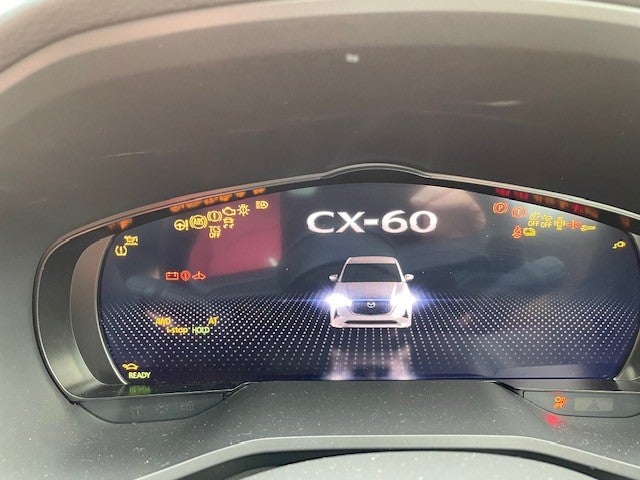
The top Takumi has 20-inch black machined alloy wheels and body coloured mirrors, combined with chrome plated signature wing grille treatment and side window surround, plus gloss black bar radiator grille. The optional convenience pack include privacy glass, 360 view monitor (now with see through view) and wireless phone charging, while the driver assistance pack adds additional active safety technology.
The base model’s comfort pack adds 20-inch alloy wheels, electric front seats, front seat ventilation, rear seat heaters and the driver personalisation system. The CX-60 line also introduces the new Rhodium White premium metallic paint.
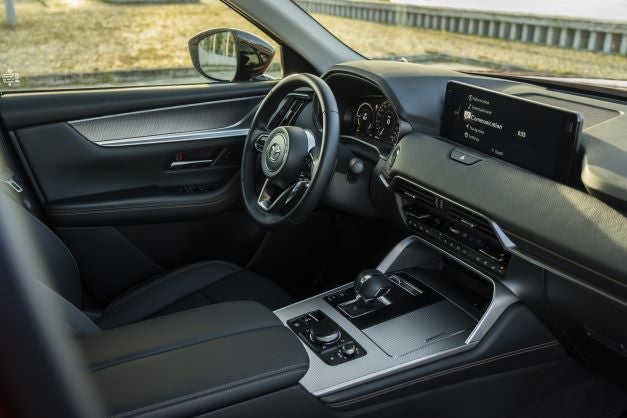
New technology makes its debut with the Mazda CX-60: See-Through View is a 360-degree monitor with extended field of view at low speeds; Hill Descent Control (HDC) assists in safely descending steep slopes with slippery or rough road surfaces and Adaptive Cruise Control (i-ACC), can now incorporate speed limits from Traffic Sign Recognition.
The CX-60 is the first of two new models from the company’s Large Product group to be introduced throughout Europe during the next two years with the second being the three-row CX-80.
The automaker last October announced plans to expand its SUV lineup starting from 2022 and new models include the CX-50 (a more butch looking CX-5) produced at a new US plant shared with Toyota, as well as this CX-60, CX-70, the aforementioned CX-80 and CX-90, all of which are slated for introduction between 2022 and 2023.
The CX-50 is a crossover SUV added as a new core model to the lineup and introduced in the US “where a strong SUV presence as well as off-road performance are in high demand”.
This model belongs to the ‘small product group’ like the 3 and CX-30.
The CX-60, CX-70, CX-80 and CX-90 will offer two body types with two seating arrangements: two rows and three rows.
Markets with narrower roads and smaller parking lots such as Europe and Japan, get the two-row CX-60 and upcoming three-row CX-80.
The CX-70 and CX-90 will be sold in North America and other markets “where larger models with a big presence are preferred”. Both models have the wide body with the CX-70 having two rows of seats and the CX-90 three.
In North America where high power performance is valued, Mazda will introduce both turbo-charged I6 petrol engine models and plug-in hybrid models.
Due to the enduring popularity of diesel engines in Japan, a straight-six Skyactiv-D diesel model with a 48V mild hybrid system and plug-in hybrid models will be introduced there.
Through the introduction of these models, Mazda plans to complete the electrification of all the models it produces by 2030.
The CX-5, popular worldwide since its launch in 2012, isn’t going away. Instead it “will see its design evolve and its model lineup enhanced through continuous product improvement. Furthermore, introducing the latest safety technologies and connectivity features, we will increase the appeal of the vehicle and give it the space to continue growing as part of our crossover SUV lineup”, Mazda said.
The CX-60 is a great new addition to the European Mazda line, offering a degree of electrification, albeit at a price, and with notable improvements and enhancements across the board as well as evolved styling and more interior and cargo room. And, for those for whom the premium is a bit steep, the CX-5 is now mild hybrid across the range with its future assured.
